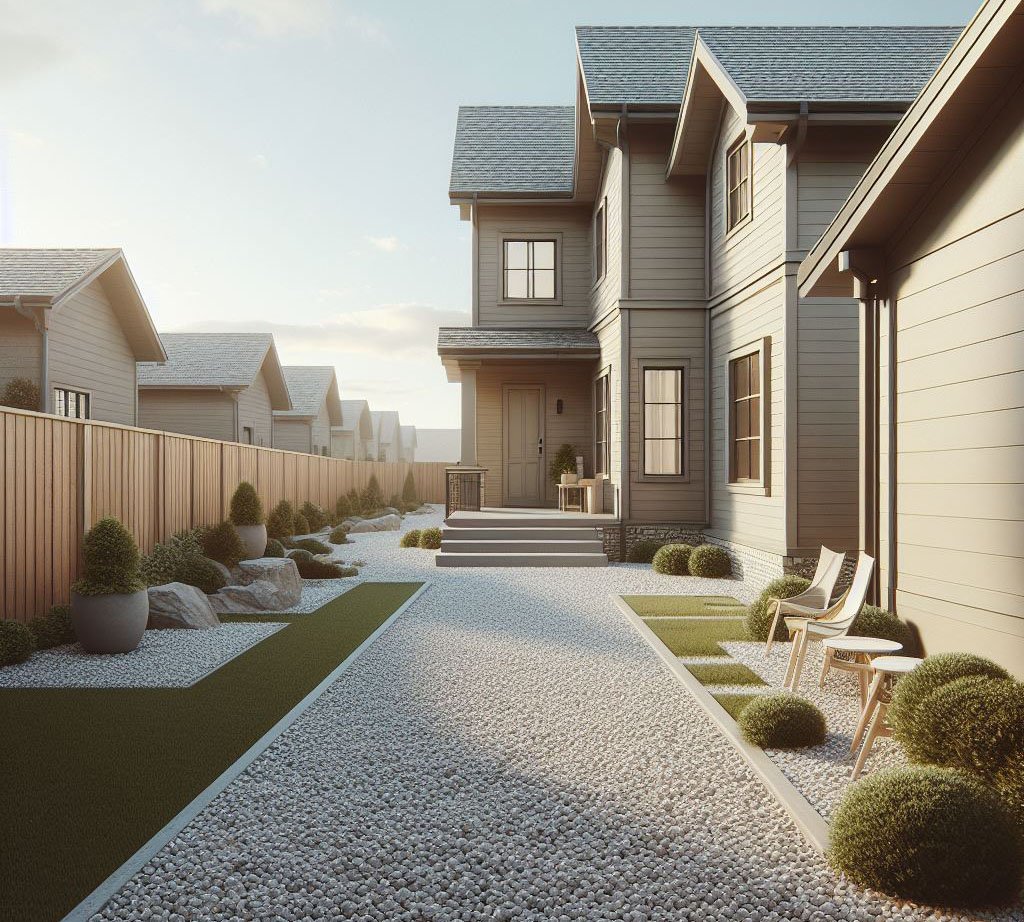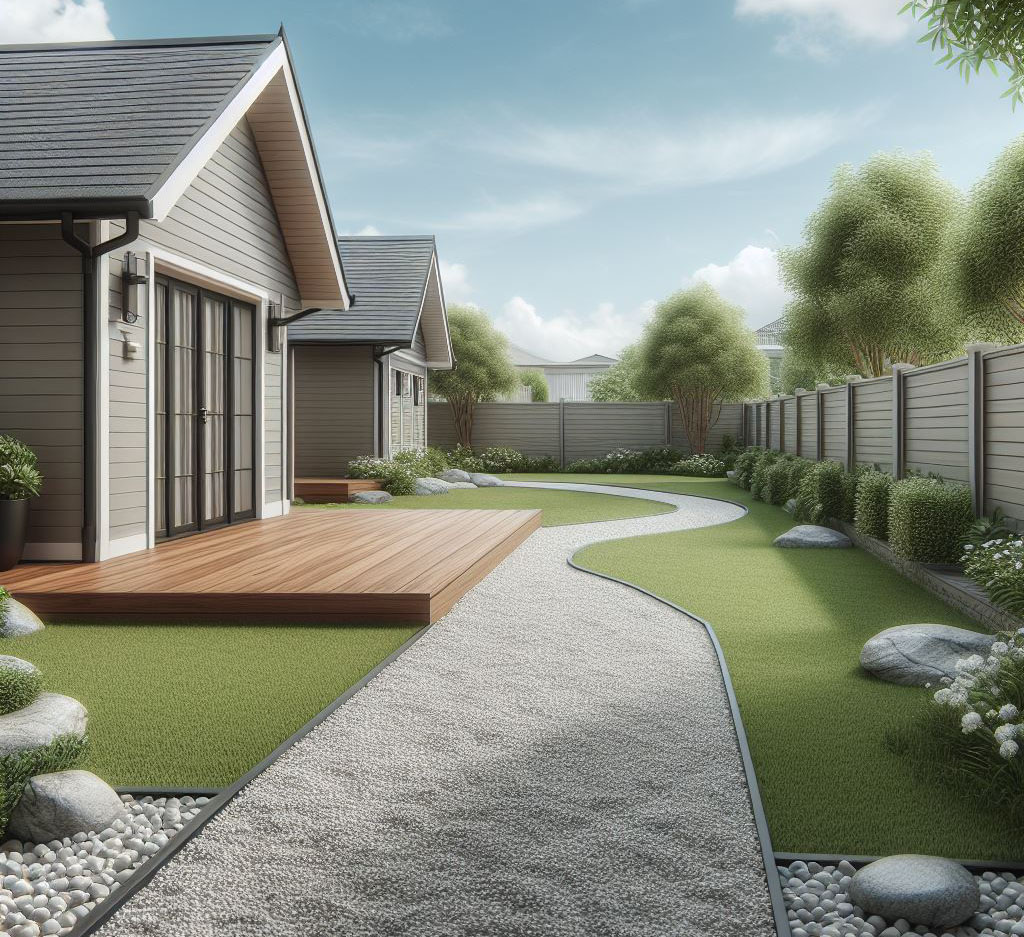A gravel walkway is more than a mere path, it’s a bridge between the natural and the constructed, offering both aesthetic beauty and practical utility. These walkways excel in managing rainwater through their permeable nature and stand the test of time with minimal maintenance. Their charm lies not only in their appearance but also in their versatility and functionality, making them an invaluable addition to any landscape.

Planning Your Gravel Path
The success of a gravel walkway begins long before the first stone is laid, it starts with thorough planning. A well-designed walkway appears as a natural extension of the landscape, guiding visitors with ease and complementing the surrounding environment:
- Location and Layout. The pathway should intuitively connect points of interest in your garden or yard, creating a logical flow that enhances the overall layout without disrupting the natural setting. Use flexible markers like hoses or strings to experiment with different routes.
- Measuring Up. Precision in measurement is crucial. Determine the length, width, and desired depth of your walkway to calculate the volume of gravel needed. This step ensures you purchase the right amount of material, avoiding delays or excess.
- Material Matters. Beyond the gravel, consider the supporting cast: landscaping fabric to deter weeds, edging to define the path, and a base layer of crushed stone for stability. Each element plays a critical role in the longevity and effectiveness of the walkway.

Types of Gravel for Walkways
The choice of gravel significantly influences the walkway’s character and functionality. Each type of gravel brings its own aesthetic and practical benefits to the table:
- Pea Gravel. Its smooth texture and varied colors make pea gravel a favorite for creating inviting, visually appealing paths. However, its rounded shape can lead to shifting, making it better suited for areas with light foot traffic.
- Crushed Stone. This option offers a more stable footing due to its angular shape, which allows the pieces to lock together. It’s ideal for paths that will see more use or need to bear heavier loads.
- River Rock. With its larger size and decorative appearance, river rock can serve as a striking design element. Though not ideal for the main walkway surface due to its unevenness, it works well as an accent or border.
Selecting the right type of gravel is a balance of form and function, taking into account the walkway’s intended use, the existing landscape style, and maintenance considerations.
Essential Materials and Tools
A successful gravel walkway project requires not just the right type of gravel but also a suite of materials and tools designed to ensure the path is built to last:
- Gravel. The centerpiece of your project, chosen based on the insights provided above.
- Landscaping Fabric. This underlayment prevents weeds from encroaching on your walkway, preserving its appearance and integrity.
- Edging Material. Essential for keeping the gravel in place and maintaining the path’s shape. Options include metal, plastic, or natural stone.
- Base Layer Materials. A solid foundation is key, crushed stone or builder’s sand will provide the necessary stability.
- Tools. The basics include a shovel for excavation, a rake for spreading and leveling, a tamper for compacting the base, and a wheelbarrow for moving materials.

Step-by-Step Construction Guide
Embarking on the construction of a gravel path in your landscape is more than a mere improvement, it’s an endeavor to blend functionality with aesthetic appeal, creating a path that not only welcomes but withstands the elements with grace. With years of hands-on experience in the field of renovation and construction, let’s navigate the detailed process of constructing a durable, beautiful gravel path.
- Site Preparation. The journey to a lasting gravel walkway begins with thorough preparation. Clear the area of any vegetation, debris, or obstacles. Achieving a proper grade is crucial—not only for the aesthetics but also for effective water management. Aim for a gentle slope away from structures to ensure drainage, using a rake or a landscaping rake for evenness. Compaction of the soil is next, providing a solid base for the walkway. For small paths, a hand tamper suffices, but larger projects might warrant the rental of a plate compactor.
- Ensuring Adequate Drainage. A walkway that doubles as a makeshift stream during heavy rains is a nuisance. To prevent water accumulation, consider installing a French drain system along or beneath your walkway. This involves digging a trench, placing a perforated pipe wrapped in landscaping fabric, and covering it with gravel, effectively channeling water away from the path.
- Landscaping Fabric. To combat weed growth, lay landscaping fabric across the prepared base, overlapping edges for complete coverage. Secure it with garden staples to keep it in place. This barrier allows water to pass through while preventing weeds from taking root in your walkway.
- Edging Installation. Edging is not just about aesthetics, it’s about containment. Install metal, plastic, or stone edging to define your walkway and prevent the gravel from spreading into your lawn or garden. Ensure it’s firmly anchored in place to withstand foot traffic and the elements.
- Gravel Application. With the groundwork laid, it’s time to bring in the gravel. Distribute it evenly along the path to a depth of about 2 to 3 inches, using a rake for smaller areas or a landscaping screed for larger ones to achieve a level surface.
- Adding Stepping Stones. For a touch of elegance and improved stability, embed stepping stones or pavers into the gravel. They provide solid footing and reduce the displacement of gravel, enhancing the walkway’s functionality and visual appeal.
Maintenance and Care
- Regular Raking. To maintain the appearance and evenness of your gravel walkway, regular raking is essential. It’s akin to grooming, keeping the surface smooth and inviting.
- Gravel Replenishment. Over time, gravel may compact or migrate. Periodically adding a new layer of gravel ensures the walkway remains level, well-defined, and visually appealing.
- Weed Management. Despite the landscaping fabric, some weeds may emerge. Regular inspection and prompt removal of weeds, either by hand or using a targeted treatment, will keep your walkway looking pristine. Be cautious with herbicides, as they can affect surrounding plant life.
Design Ideas and Inspiration
- Creative Combinations. Don’t hesitate to mix different gravel colors and sizes or to introduce patterns within your walkway for added visual interest. These variations can highlight certain areas or lead the eye along the path.
- Pathway Integration. A gravel walkway should complement your overall garden design. Consider its placement and curve it naturally around garden beds, trees, or other landscape features for an organic, integrated look.
FAQ Section
To calculate the required volume of gravel, measure the walkway’s length, width, and desired gravel depth, then convert these dimensions into cubic feet or yards. It’s prudent to purchase a bit more than calculated to account for settling and spreading.
Yes, but first, remove any grass and compact the underlying soil to prevent uneven settling. The landscaping fabric is crucial here for separating gravel from soil and minimizing weed growth.
Proper installation of landscaping fabric is key. Additionally, regular maintenance and prompt removal of any weeds that do emerge will keep your walkway clear.
Pea gravel is aesthetically pleasing and comfortable underfoot but may shift over time. Using stepping stones or pavers can enhance stability and prevent displacement.
Inspect your walkway annually. Replenish the gravel as needed to maintain its depth and appearance, typically every few years, depending on usage and weather conditions.
Incorporating stepping stones or pavers provides a firmer walking surface, while selecting a more compact gravel type or using a stabilizing grid can also enhance stability.
